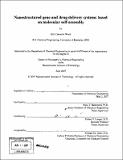| dc.contributor.advisor | Paula T. Hammond. | en_US |
| dc.contributor.author | Wood, Kris Cameron | en_US |
| dc.contributor.other | Massachusetts Institute of Technology. Dept. of Chemical Engineering. | en_US |
| dc.date.accessioned | 2007-10-22T17:40:14Z | |
| dc.date.available | 2007-10-22T17:40:14Z | |
| dc.date.copyright | 2007 | en_US |
| dc.date.issued | 2007 | en_US |
| dc.identifier.uri | http://hdl.handle.net/1721.1/39350 | |
| dc.description | Thesis (Ph. D.)--Massachusetts Institute of Technology, Dept. of Chemical Engineering, 2007. | en_US |
| dc.description | Includes bibliographical references. | en_US |
| dc.description.abstract | Molecular self-assembly describes the assembly of molecular components into complex, supramolecular structures governed by weak, non-covalent interactions. In recent years, molecular self-assembly has been used extensively as a means of creating materials and devices with well-controlled, nanometer-scale architectural features. In this thesis, molecular self-assembly is used as a tool for the fabrication of both gene and drug delivery systems which, by virtue of their well-controlled architectural features, possess advantageous properties relative to traditional materials used in these applications. The first part of this thesis describes the solution-phase self-assembly of a new family of linear-dendritic "hybrid" polymers with plasmid DNA for applications in gene therapy. It begins with an overview of the design of next-generation, non-viral gene delivery systems and continues through the synthesis and validation of hybrid polymer systems, which possess modular functionalities for DNA binding, endosomal escape, steric stabilization, and tissue targeting. This part of the thesis concludes with applications of these systems to two areas of clinical interest: DNA vaccination and tumor targeted gene therapy. | en_US |
| dc.description.abstract | (cont.) The second part of this thesis describes the directed self-assembly of polymeric thin films which are capable of degrading in response to either passive or active stimuli to release their contents. It begins with a description of passive release thin films which degrade by basic hydrolysis to release precise quantities of model drug compounds. These systems can be engineered to release their contents on time scales ranging from hours to weeks and can also be designed to release multiple drugs either in series or in parallel. Later, field-activated thin films which release their contents in response to an external, electrical stimulus are described and characterized in detail. Together, these approaches combine rapid and inexpensive processing, the ability to conformally coat any surface regardless of composition, size, or shape, and the ability to release multi-drug or multi-dose schedules, and as such they may find applications in a range of areas. | en_US |
| dc.description.statementofresponsibility | by Kris Cameron Wood. | en_US |
| dc.format.extent | 202 p. | en_US |
| dc.language.iso | eng | en_US |
| dc.publisher | Massachusetts Institute of Technology | en_US |
| dc.rights | M.I.T. theses are protected by copyright. They may be viewed from this source for any purpose, but reproduction or distribution in any format is prohibited without written permission. See provided URL for inquiries about permission. | en_US |
| dc.rights.uri | http://dspace.mit.edu/handle/1721.1/7582 | |
| dc.subject | Chemical Engineering. | en_US |
| dc.title | Nanostructured gene and drug delivery systems based on molecular self-assembly | en_US |
| dc.type | Thesis | en_US |
| dc.description.degree | Ph.D. | en_US |
| dc.contributor.department | Massachusetts Institute of Technology. Department of Chemical Engineering | |
| dc.identifier.oclc | 173612251 | en_US |
